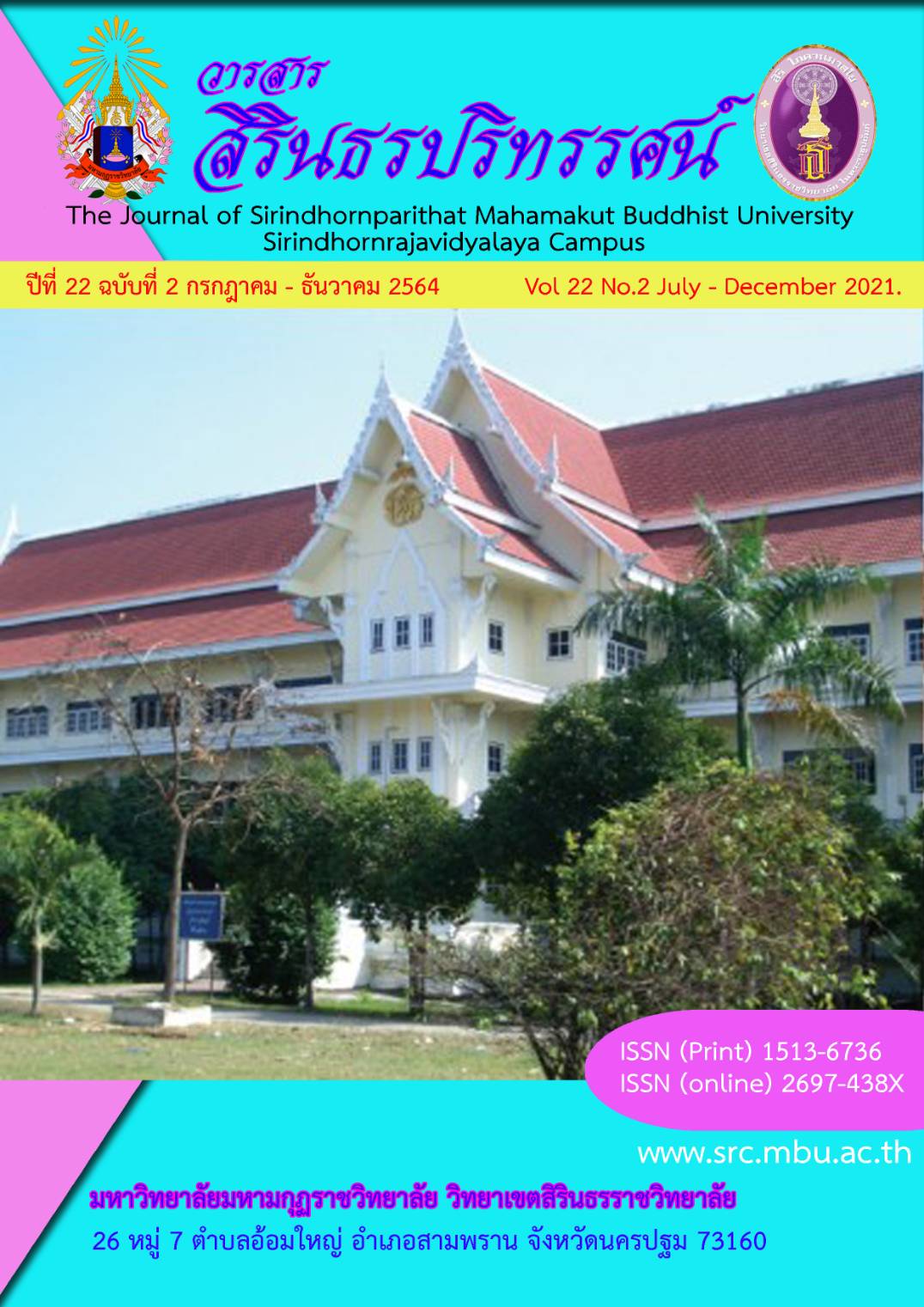The Government Developmental Model of Theravada Clergy (Maha Nikai): A Case Study of Central Region Sangha
Keywords:
Development Model, Administration, Theravada SanghaAbstract
The Theravada Sangha is governed by the Dharma and Vinaya, which are the Law Buddhism. In the past, the Sangha Administration in Thailand was organized in accord with the royal command and customs that were inconsistent with the Dharma and Vinaya. The Sangha Administration Act, R.E. 121, and the Sangha Act, 1962, were enacted as the main law governing the Thai Sangha. It has been more than 59 years, but there are still flaws or gaps that damage Buddhism which include the organizations of Sangha. The objectives of this research were to: (1) study the context and problems of the development of Theravada Sangha (Maha Nikaya) Sangha Administration: A case study of the Sangha Council of Central Region; (2) study a guideline for the development of Theravada Sangha (Maha Nikaya) Sangha Administration: Regional Sangha Councils. Central Region; and (3) present the form of administration development of Theravada Sangha (Maha Nikaya): Sangha in the Central Region. This research employed a qualitative research method. The focus group discussion and in-depth interviews were conducted with 26 experts, which include 15 laity and 11 monks. The sample informants consisted of administrative monks, ordinary monks in the central region, religious scholars, and academics in political science. The research findings showed that: 1) in the context and problems in the development of the administration of Theravada Sangha (Maha Nikaya): Sangha Councils in the Central Region, there were problems and obstacles in three aspects: the problem of the monks, the lack of efficiency in administration and the problem of administrative structure; 2) in the guidelines for the development in the form of administration of Theravada Sangha (Maha Nikaya): Sangha Councils in the Central Region that lead to good administration consisted of three principles. They were the principle of self-development, monks needed to develop themselves by using Three Studies principles (Precept, Concentration and Wisdom), the principle of human development in organization using The Seven Sappirisadhammas, and the principle of organizational development using the six principles of good governance; so that they could promote the operation of Sangha affairs more efficient in six areas, namely the Administration, the Religious Studies, The Education Welfare, the Propagation, the Public Utilities and the Public Welfare; and 3) from this research, it was found that a pattern of administrative development of Theravada Sangha (Maha Nikaya): a case study of The Sangha Council of Central Region, was based on TSG MODEL consisted of developing monks by the Three Studies principles, developing people with The Seven Sappurisadhammas and developing work with The six Principles of Good Governance. The TSG MODEL was useful for the development of administration of Theravada Sangha (Maha Nikaya): a case study of the Sangha of the central region, to reach the goals of working in the Sangha organization in order to have 1) Good people (Virtue) 2) Smart people (Intelligent) and 3) Happy organizations (Happy). They constituted the way for honoring good people, promoting good governances, and creating a new corporate culture.
References
สุมน อมรวิวัตน์. (2547). การพัฒนาการเรียนรู้ตามแนวพุทธศาสตร์. พิมพ์ครั้งที่ 3. กรุงเทพฯ : มหาวิทยาลัย สุโขทัยธรรมาธิราช.
ไชยวัฒน์ ค้ำชู และคณะ. (2545). แนวทางการนำหลักธรรมาภิบาลมาประยุกต์ใช้กับองค์กรปกครองท้องถิ่น.กรุงเทพฯ : บพิธการพิมพ์.
ธิดา สาระยา. (2539). อารยธรรมไทย. กรุงเทพฯ : เมืองโบราณ.
พระเทพเวที (ประยุทธ์ ปยุตฺโต). (2532). พุทธธรรม ฉบับปรับปรุงขยายความ. พิมพ์ครั้งที่ 5. กรุงเทพฯ : โรงพิมพ์ มหาจุฬาลงกรณราชวิทยาลัย.
พระเมธีธรรมาภรณ์ (ประยูร ธมฺมจิตฺโต) (2539). การปกครองคณะสงฆ์ไทย. พิมพ์ครั้งที่ 9. กรุงเทพฯ : บริษัท สหธรรมิก จำกัด.
พระไพศาล วิสาโล. (2546). แนวโน้มพระพุทธศาสนาในอนาคต. กรุงเทพฯ : มูลนิธิสดศรีสฤษดิวงศ์
พระไพศาล วิสาโล. (2552). พระพุทธศาสนาไทยในอนาคต แนวโนมทางออกจากวิกฤต. กรุงเทพฯ : โรงพิมพ์วีพริ้นท,
พระพรหมคุณาภรณ์ ( ป.อ. ปยุตฺโต).(2545). การพัฒนาการนับถือศาสนาของคน. พิมพ์ครั้งที่ 23. กรุงเทพฯ : บริษัทพิมพ์สวย จํากัด.
พระพรหมคุณาภรณ์ (ป.อ.ปยุตฺโต). (2551). พจนานุกรมพุทธศาสตร์ฉบับประมวลศัพท์. พิมพ์ครั้งที่ 12. กรุงเทพฯ : โรงพิมพ์มหาจุฬาลงกรณราชวิทยาลัย.
พระมหาสัญญา ขนฺติธมฺโม (ตรีสวัสดิ์). “รูปแบบการปกครองสงฆ์ไทยในอนาคต” วารสารสันติศึกษาปริทรรศน์. 6 (2).711-712.
พระสามารถ อานนฺโท. (2549). ภาวะผู้นำตามหลักสัปปุริสธรรม. (ปริญญานิพนธ์). กรุงเทพฯ: มหาวิทยาลัยมหามกุฏราชวิทยาลัย.
มินตรา ศรนิมิต. (2563). การปฏิบัติราชการหลักธรรมาภิบาล. Journal of Roi Kaensarn Academi. 5 (1).34
ราชบัณฑิตยสถาน. (2546). พจนานุกรมฉบับราชบัณฑิตยสถาน พ.ศ.2554. พิมพ์ครั้งที่ 2. กรุงเทพฯ : ศิริวัฒนา อินเตอร์พริ้นท์.
สถาบันราชประชาสมาสัย. (2549). ธรรมาภิบาลบันดาลสุข. กรุงเทพฯ : กระทรวงสาธารณสุข.
วิชาญ ทรายอ่อน, (2559). ปฏิรูปและจรรโลงกิจการพระศาสนา, วารสารสำนักวิชาการ สำนักงานสภาผู้แทนราษฎร. 1-7.
วินัย วีระวัฒนานนท์. รองศาสตราจารย์ ดร. (2538). สิ่งแวดล้อมและการพัฒนา. กรุงเทพฯ: เรือนแก้วการพิมพ์.
สนธยา พลศรี. (2547). ทฤษฎีและหลักการพัฒนาชุมชน. พิมพ์ครั้งที่ 5. กรุงเทพฯ : โอเดียนสโตร์.
สุเทพ สุนทรเภสัช. (2525).“ศาสนาในนครศรีธรรมราช: “ศาสนากับการพัฒนาทางสังคม เศรษฐกิจและการเมือง”, รวมบทความประวัติศาสตร์. มปท.
สุนทร ณ รังษี, (2539). การปกครองคณะสงฆ์ : อดีต ปัจจุบัน อนาคต, วารสารพุทธศาสน์ศึกษา. 3 (3). 6-18.
อำนวย วีรวรรณ. (2555). พระมหากษัตริย์ไทยกับพระพุทธศาสนา. กรุงเทพฯ: อมรินทร์พริ้นติ้งแอนด์พับลิชชิ่ง.
Mabel Haynes Bode. (1965) The Pali Literature of Burma, (Rangoon: Barma Research Society.
Phramongkoldhammavithan. (2019 January – February). To Study on the threefold training for Human Resource Development. Humanities, Social Sciences and arts. 12 (1) 890.
Downloads
Published
Issue
Section
License
Copyright (c) 2022 Mahamakut Buddhist University

This work is licensed under a Creative Commons Attribution-NonCommercial-NoDerivatives 4.0 International License.
บทความที่ได้รับการตีพิมพ์เป็นลิขสิทธิ์ของ มหาวิทยาลัยมหามกุฏราชวิทยาลัย วิทยาเขตสิรินธรราชวิทยาลัย
ข้อความที่ปรากฏในบทความแต่ละเรื่องในวารสารวิชาการเล่มนี้เป็นความคิดเห็นส่วนตัวของผู้เขียนแต่ละท่านไม่เกี่ยวข้องกับหาวิทยาลัยมหามกุฏราชวิทยาลัย วิทยาเขตสิรินธรราชวิทยาลัย และคณาจารย์ท่านอื่นๆในมหาวิทยาลัยฯ แต่อย่างใด ความรับผิดชอบองค์ประกอบทั้งหมดของบทความแต่ละเรื่องเป็นของผู้เขียนแต่ละท่าน หากมีความผิดพลาดใดๆ ผู้เขียนแต่ละท่านจะรับผิดชอบบทความของตนเองแต่ผู้เดียว




